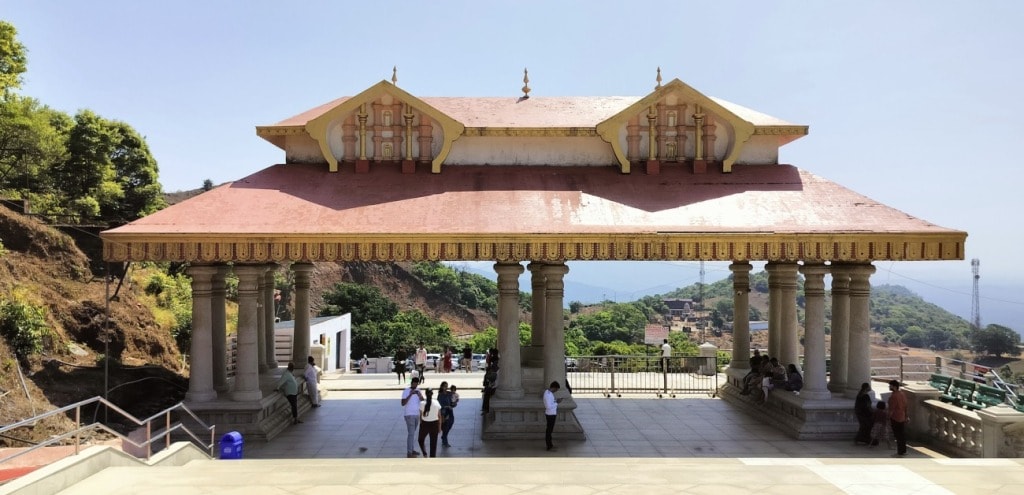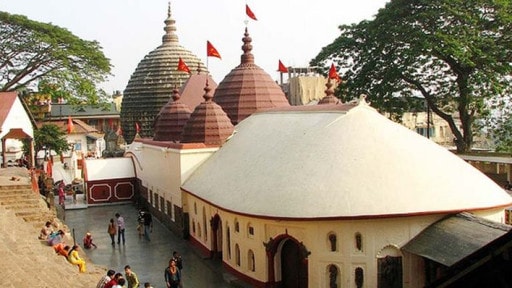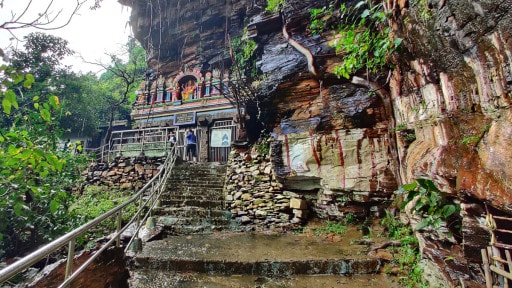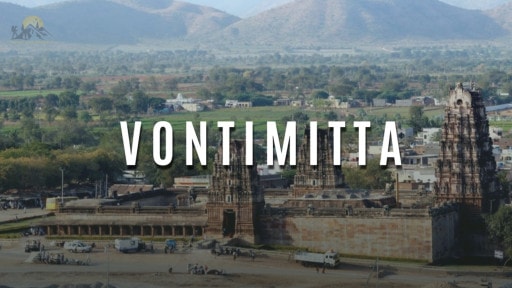Talakaveri Temple or Talacauvery is a popular Hindu holy pilgrimage site and is the origin point of the sacred river Kaveri nested in the Coorg district of Karnataka, India on the hills of Brahmagiri. This sanctuary is dedicated to Goddess Kaveriamma, who is considered as the river’s guardian and located at an elevation of 1276 meters above sea level.
Though this place is the source of the Kaveri River, the flow of water is not visible every season, except during the monsoon rains. Apart from just being a sacred place, it is well known for its natural essence and serene atmosphere filled with lush greenery during monsoon and a perfect spot for trekking. Talakaveri is around 8 km from Bhagamandala and 48 km from Madikeri or Coorg.
Origin of River Kaveri
There are various myths around the sacred origins of Kaveri River, which is also called the Dakshin Ganga and often spelled as Cauvery. The legends state a well-known story, there was a king for the Kavera region, and he was a great devotee of Lord Shiva and one day he was granted a wish from the lord when he was in deep meditation, a wish for happiness in the region. The king was also blessed with a baby girl by the grace of shiva and she was named Kaveri.
All the wishes of the region will be fulfilled by the blessed girl Kaveri. During the rule of Surapadma, a demon, she was married to Sage Agastya as the sage wanted to save the people and the region of Kavera from the demon king. To protect his wife, when the demon’s tyranny increased, Agastya Rishi turned his wife into water and placed her into his holy pitcher or Kamandal. After helding the River Kaveri in his Kamandalu he engaged in meditation to please lord shiva to help him during the tough phase.
Lord Ganesha took an avatar of a crow and perched on the Kamandalu, disturbing the sage and he tried to shoo away the crow. But his efforts went in vain, and the water came out streaming and flowed down known as River Kaveri. Thus, it is assumed that the Kaveri River was brought down to earth by Sage Agastya and jumped out from a Kundike on the hillside and henceforth it has the name Talakaveri or the source of River Kaveri.
Suggested Read: Yana Caves
TalaKaveri Temple, Coorg – How to Reach, History, Timings, Entry Fee

Significance of Talakaveri Temple
Goddess Kaveramma is the main deity of the temple and is dedicated to Lord Agastheeswara as there is a link between Kaveri and Sage Agastya. Talacauvery moreover comprises two shrines, one devoted to Master Shiva and it has one of the antique Shivalinga, it’s a place where Lord Shiva showed up before the Sage. Another temple is dedicated to Lord Ganesha who played a key role in releasing the waters of Kaveri from the sage Kamandalu and it has a holy Ashwantha tree in the premises. The connection between Kaveri and Lord Ganesha spreads to Srirangam and a holy Ranganatha temple is built, and the deity Lord Ganesha’s is worshiped here.
Talakaveri is a sacred temple for Hindus and there is a small water tank built at the place where the river Kaveri originated, called the holy Kundike for pilgrims to take bath before offering prayer to the dietary. River Kaveri is at distance of 8km to Bhagamandala and it appears as a spring and disappears underground and water flows secretive and joins the two rivers Kannike and Sujyoti and they form a revered Triveni sangama, or the union of the three rivers. As per the belief of the native people, the water at Talacauvery has unbelievable healing powers and a dip in the holy water has cured various physical and emotional griefs.

If you climb up on a few series of steps near the temple it leads to the hilltop of Brahmagiri and from there you can enjoy a 360-degree view of the stunning landscape of the rolling hills. The shrine was refurbished significantly by the state government in 2007 and the interesting part is, though this place is the source of the Kaveri River, the flow of water is not visible every season, except during the monsoon rains.
How to Reach Talakaveri Temple
By Air:
Talakaveri or Coorg doesn’t have an airport of its own, the closest airport terminal is Mangalore International Airport which is around 150 km away. Another best option is Bangalore airport which is around 297.3 km away or opt taking Kannur International Airport from there it’s just around 120 km away to Coorg. From the airport take any means of public transportation to reach Talakaveri temple.
By Train:
The nearest railway track to reach Talakaveri temple is Mysore, just around 140km. Other choices incorporate Hassan and Mangalore Railroad stations, Coorg is 100 km from Hassan and 120 km from Mangalore and Mysore. From the station take any means of public transportation to reach the shrine.
By Bus or By Road:
Talakaveri Temple has great public transportation as the city is well connected with major cities in Karnataka and other states like Bangalore, Mangalore, Hassan, and Mysore. KSRTC operates frequent buses between Karnataka and Kerala. Travelers can also choose to drive their own vehicle or rent a car to reach the temple from various cities as the road connectivity is very good.
Road route from Mysore: Mysore – Hunsur – Periyapatna – Bylakuppe – Koppa – Kushal Nagara-Cauvery Nisha Dharma – Hosakote – Suntikoppa – Madikeri- Abbey Falls – Bhagamandala – Talacauvery
| City | Distance |
| Mysore to TalaKaveri | 150 km |
| Madikeri or Coorg to TalaKaveri | 48 km |
| Bangalore to TalaKaveri | 290 km |
| Mangalore to TalaKaveri | 160 km |
| Bhagamandala to TalaKaveri | 8 km |
| Kasaragod to TalaKaveri | 110 km |
Talakaveri Temple Timings and Entry Fee
Timings: Open from 6am to 6pm each day
- Darshan from 6am to 7am
- Abhisheka from 7am to 7:30 am
- Darshan from 7:30 am to 5:30 pm
- Maha Mangala Aarti from 5:45 pm to 6:00 pm
- Temple closed at 6:00pm
Entry Fee: No fee
Suggested Read: Vibhuthi Falls
Best time to visit Talakaveri Temple
Being one of the furthermost picturesque hill stations in South India, the holy sanctuary of Talakaveri is open for tourists all throughout the year, but the best time to visit is from October to May when the weather is quite pleasant to witness the scenic beauty.
It is highly advised not to visit during the monsoon season (July-September) which can bring heavy rains and it’s usually very crowded during the summer season in Coorg and other places including Talakaveri.
Festivals celebrated at Talakaveri Temple
Kaveri Sankramana: The most popular and renowned festival Tula Sankramana is celebrated on a grand scale each year in mid-October on the first day of Tula Masa month. Where thousands of devotees visit the temple every year from various parts of the country to take a dip in the holy river and to offer their prayers to Goddess Cauvery. Around the time of festival tourists get to witness a rise in the water level of the river’s Kaveri and is usually called as Thirthodbhava and devotees can also carry holy water to their homes.
On this auspicious occasion the puja and the other carnivals activities are performed with the local traditional and folk music. Visitors get to see ancient traditions, taste some local food and buy local products and souvenirs from the trade event, which is held by the local vendors, making the festival fascinating and entertaining for everyone.
Accommodation
There are countless accommodation choices accessible from budget friendly hotels to luxury resorts, lodges etc. around the temple and surrounding area. As per your finances and constraints choose the best option that works.
Conclusion
Talakaveri is not only a center for religious pilgrimage sites but an eco-tourism spot where travelers get to enjoy the stunning beauty of the Western Ghats and an ideal place for trekking through the lush greenery forests, variety of flora and fauna. Due to the increase of tourists every year the infrastructure around the sanctuary and surrounding area has seen gradual improvement.
The origin of holy river Kaveri has an immersed historical root and developing leisure industry landscape, remains to be an ideal place for spiritual explorers and nature lovers, offering a knowledge that is both enduring and in harmony with the modern tourism trends. People can also hike up the Brahmagiri Hills across the scenic trails that extend scenic vistas of the slopes and adjoining landscape.
Suggested Read: Honnavar Travel Guide





